Fly Fishing Fabisch, the Weekly Picture Archive 3 - 2019
Weekly pictures Archive 2019three
The Weekly pictures archive 2019 part three
.
Here is a new weekly picture archive 2019, part three at Fabisch fly fishing. Most posts in this archive will be weekly pictures from Canada. The Themes are nature, fly fishing or fly tying and panning for gold. Look forward to pictures from British Columbia and the Yukon.
.
.
Our Camp
It would be possible to camp out in a tent in the Yukon, but it would require very strong nerves. If you work all day prospecting, you need a good night´s sleep, without getting startled by any cracking twig or the like. A caravan or a motorhome, however, also offer only limited security. In case a big bear really wants to get inside, he is bound to make it. It will take more effort than breaking into a tent, though. The noise alone is going to wake any sleeper, giving him the possibility to get his bear spray ready, provided it is close at hand.
Camping way out in the wilderness is quite different from staying in a campground. No tap water, no electricity and no sewage pipe. This means best avoiding to waste water, if the nearest source is 60 km and a mountain pass away. Well, a pass consisting of a dirt road that any rain may quickly turn into slippery mud. Of course you can shop food and drinks to last you for a certain length of time, but unfortunately our freezer gave up on us for lack of propane early in our trip. All we could do was discard the ruined provisions.
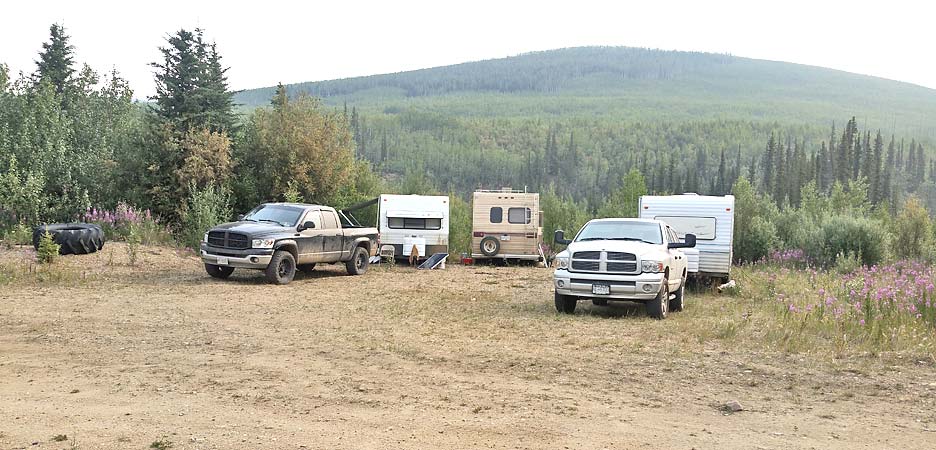
Weekly picture 29 2019
Unless you want to attract bears, you had better carry a shovel when you go potty: dig a hole first and cover any feces well with soil once you´ve finished, and - important - do it well away from camp!
.
People with a romantic view of prospecting will be shocked at all the brutal work that needs to be done every single day. Prospecting is not about fiddling around with a washpan on the banks of the brook. First of all you need to dig holes - big ones, not just tiny ones! Unless you dispose of a well-stuffed bank account, you will dig by hand using a shovel. The deeper the hole, the harder the removal of the tailings. You need several levels to stock your tailings on the way up, so you will have to shovel every single kilo a few times before you get it out of your hole.
Our deepest hole had a depth of 6.5 meters and on the bottom there was only room for a single person to scratch at the very bottom with only a real small shovel. In case the wall had crumbled at the top, the person on the bottom would not only have been dead, but also buried at the same time. The picture on the right shows this very hole at a depth of 5 m. Look how deep it is to my right. The ladder on the left side of the picture is 3.8 meters long, which is not as much as the depth of the hole (see picture in the middle). As permafrost begins at a depth of 20 cm to 1 meter, over 95% of the tailings had to be loosened using a jackhammer.
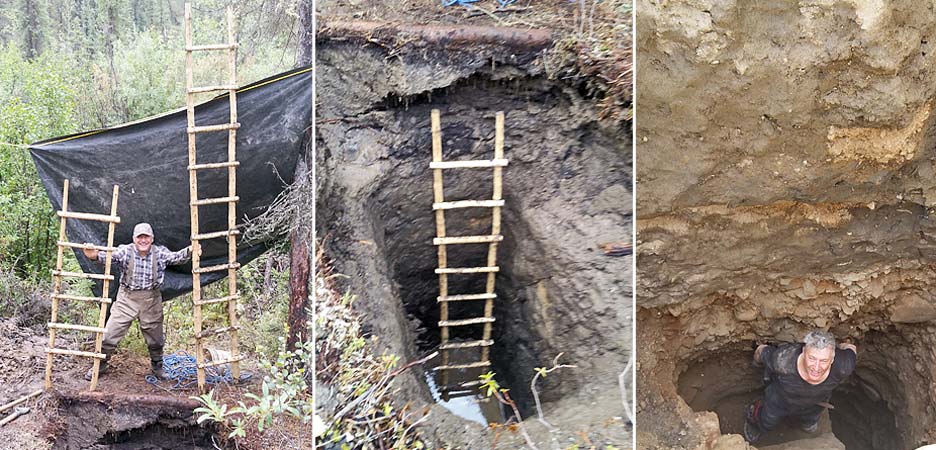
Weekly picture 30 2019
When the claim is left for the season, and you are holding a small water license, you are supposed to reclaim your site, i.e. leave it as you found it. This means lots of work that must never be underestimated. You better start right from the beginning to stock your tailings not too far away from the hole.
.
After having finished all the formalities in the Mining Bureau in Dawson City we headed down South, to Whitehorse. Our stay in Canada was to last another two weeks which gave us time enough to see a few sights. First of all we checked the Pelly River, one of the three largest rivers in the Yukon. Our interest was gold panning as well as fishing. Access is relatively easy, as the road down South leads through the town of Pelly Crossing.
This town has a well stocked supermarket allowing you to replenish your stocks of groceries and what have you. We spent three days there and tried to catch a few fish. Unfortunately a northern pike of about 50 cm was the only one worth mentioning. The only other specimens we hooked were tiny grayling, below 20 cm. The results of our gold panning were equally disappointing. The river and its scenery however are gorgeous. Regrettably there were also forest fires while we were around.
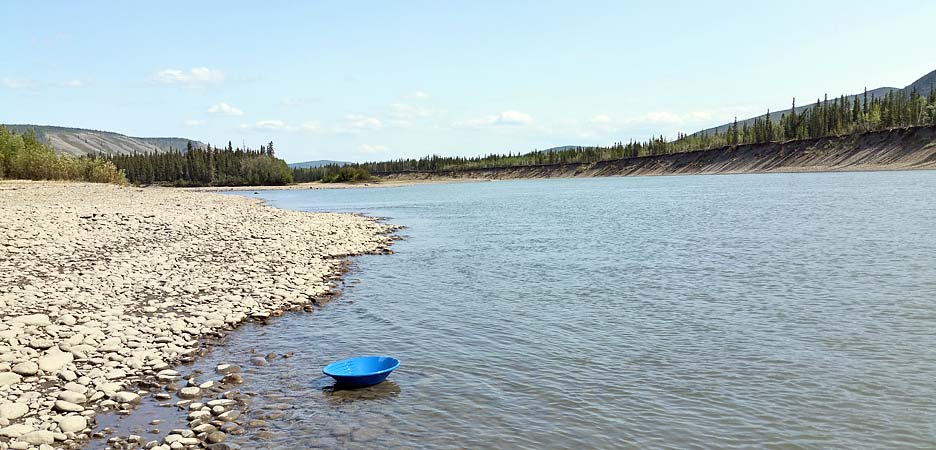
Weekly picture 31 2019
Hiking along the river will make you feel rather small. Now and then you´ll see a fishing camp of the First Nations, otherwise just pure nature. With the population density in the Yukon, this is bound to stay like this for a while.
.
As a matter of fact, we had had 3 months to look forward to - time enough for a host of things to happen. And indeed, we´ve had lots of experiences: good ones and not so good ones, interesting ones and boring ones. Even though I´ve been in Canada´s West so many times, I´ve had yet another chance to learn a lot more. Good friends helped us along a couple of times, be it with new ideas or rather profane tasks, like getting a vehicle insured for traffic. You´ll always have to pay attention carefully the first time you do something, the second, third, and fourth times then become routine.
And then, all of a sudden, the day of your flight back home pops up. The last days had been rather turbulent. What should better be taken home to Germany, what should be left in our trailer? In between we went to cast a fly into the Yukon at Whitehorse once more. We had planned to visit the canyons upstream from Whitehorse and, finally, the fish pass at the hydroelectric plant in Whitehorse. The time passes, like sand running through your fingers, until you finally find yourself sitting in an airplane bound for Frankfurt. After the first meal you manage to relax, I managed to sleep for five hours.
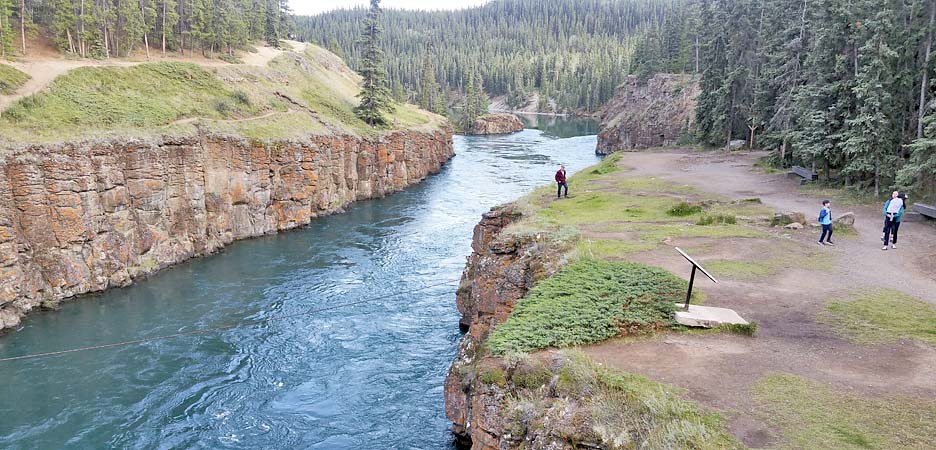
Weekly picture 33 2019
I´ll be thinking about this trip for a long time, the incredible vastness of the country, to a large extent void of humans. The intrinsic beauty of nature, and its strict conditions for survival. Finally also of the beauty of our home country, with rules entirely different from those in the Yukon.
.
The Condor Flight from Whitehorse to Frankfurt touched down on a Monday. The last part of the trip was by rail from Frankfurt to Nuremberg´s main station, and a good friend was already waiting for me there. You can imagine my wife and I enjoyed our reunion after three months away from each other. Routine caught up with me faster than I thought. The following weekend I had to teach a casting class on the Pegnitz. Every one of the participants really did a great job! One problem I expected proved a lot less difficult than I had expected.
Normally I suffer from jetlag about for about a week upon returning from British Columbia after three or four weeks. This trip to the Yukon lasted three months, so I expected the time of jetlag problems to last longer, too. Luckily I was wrong and the problems were almost negligible. May be this was due to the fact that up North there was only little difference between daytime and night. Anyway, it suited me right and I could start right back into my normal chores. My experiences in the Yukon have been deeply embedded in my memory and will stay with me for the rest of my life.
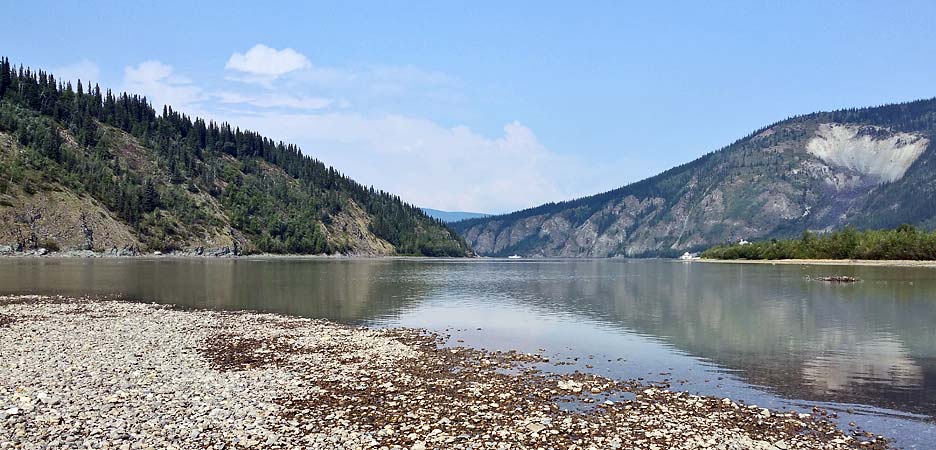
Weekly picture 34 2019
Until next years a few decisions will have to be made, but I really want to show the Yukon to my wife. An old German proverb is particularly true for the Yukon: Not every shiny object is gold!
.
After we had an exceptionally hot summer in 2018, we are getting the same all over again this year, in 2019. Most experts are hesitant to decide if this is really already climate change or just coincidence. The indisputable fact of the matter is that our watersheds are lacking water. So far we have no open conflict about the use of water, but it might come to that later. If 2019 will not be able to make up for the lack at ground-water level, this lack will increase.
Of course our fisheries in Franconia are affected. While the karst and its underground cavities will work as a sort of buffer, their capacities are not unlimited. Especially on the upper stretches the lack of water is evident. The drier it gets, the more water is needed for farming to ensure a harvest. Thus the problem for the fisheries multiplies. There is certainly no simple solution for all that, but we should work hard to find a feasible one, before it is too late for our rivers, and for us.
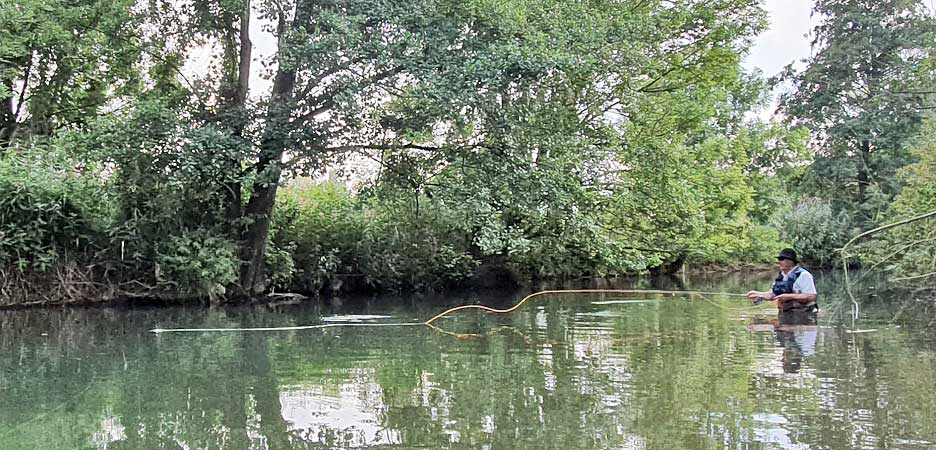
Weekly picture 35 2019
On the lower Wiesent the water level seems to be allright, but this aspect is treacherous, because the flow rate has diminished considerably. Thus the water warms up a lot more than usual and the temperatures are a hazard to both animal and plant life.
.
Taking photographs from an airplane is always a bit of a gamble. Even though you may know the route - and I´ve been to Vancouver quite a few times - success depends on a good deal of factors. In September, when arriving in Vancouver, you should prefer the right side of the plane, when taking off from Vancouver prefer the left side, otherwise you´ll be looking right into the sun. Clouds usually aren´t a big help either, neither are strong winds. Especially upon arrival the wind is critical, because the planes always touch down against the wind.So If there´s an Eastern wind when your plane touches down in Vancouver, you can forget about the right side!
In this case the pilot heads away from Vancouver almost as far as Vancouver Island and then turns back towards Vancouver. This means you can forget about your photographs. This year I was lucky in chosing my seat. The conditions were perfect over Greenland as well as during the approach to Vancouver. The pilot was following the Fraser from Hope to the airport and took the direct approach to the runway. Right after Hope he had considerably reduced the fight´s altitude, so I had many opportunities to get good shots. Hope is about 150 km from the airport.
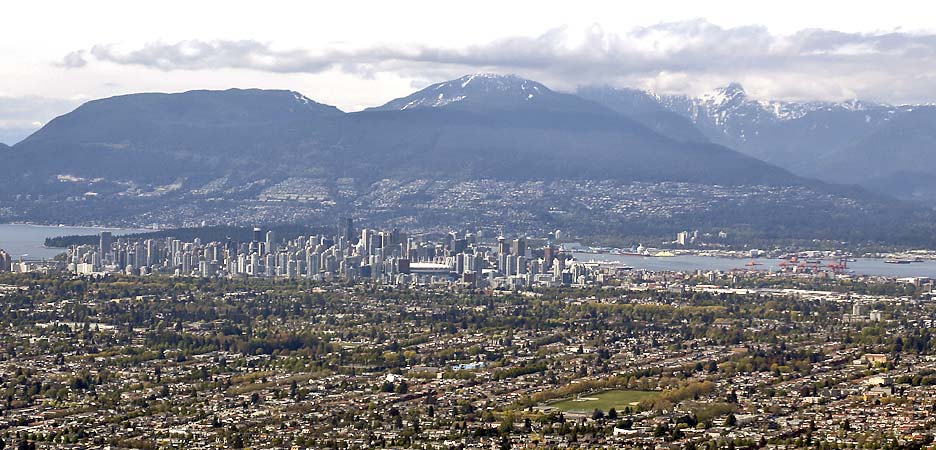
Weekly picture 36 2019
The view on the center of Vancouver was exquisit. Along the hills you can see North Vancouver. The dark part on the left side behind the skyline is Stanley Park. Should you ever fly to Vancouver, I wish you all the same conditions for your photos or videos!.
.
Weekly picture main
The Weekly picture main page
.
Weekly picture archive 2014
.
Weekly picture archive 2015
2015 part one, - 2015 part two, - 2015 part three, - 2015 part four
.
Weekly picture archive 2016
2016 part one, - 2016 part two, - 2016 part three
.
Weekly picture archive 2017
2017 part one, - 2017 part two, - 2017 part three, - 2017 part four, - 2017 part five
.
Weekly picture archive 2018
2018 part one, - 2018 part two, - 2018 part three, - 2018 part four, - 2018 part five
.
Weekly picture archive 2019
2019 part one, - 2019 part two, - 2019 part three, - 2019 part four
.
Weekly picture archive 2020
2020 part one, - 2020 part two
.
Weekly picture archive 2021
.
Wolfgang Fabisch, Nürnberger Str. 45, 90542 Eckental/Germany
✆ DE 011 49 9126 288640, Fax 011 49 9126 288643, Ⓒ Wolfgang Fabisch